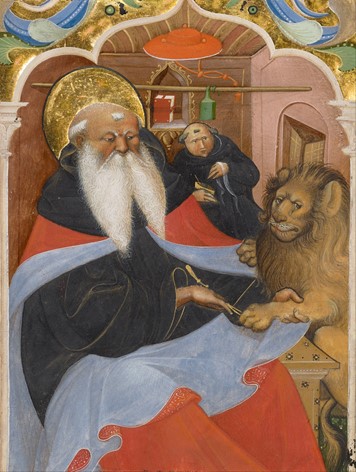
Whoever did this was clearly quite practiced at the art of taking thin bits of gold and gobs of egg yolk and turning them into pictures of disgruntled lions.
Saint Jerome fixes paws for fun
By Owen Hebbert, Contributor
Unlike most of the paintings that I discuss in this column, this particular masterpiece was found in a book rather than on a wall. I mean, it’s probably on a wall now, but that’s only because somebody decided to cut it out of the book. Imagine having the nerve—discovering a priceless illuminated manuscript and reaching for a pair of scissors as if culture is just one big scrapbooking party.
This scene portrays Saint Jerome and a lion. The lion looks grouchy while St. J. looks well-fed and the priest in the background looks concerned about the fact that there’s a lion in this painting. No doubt he would be more at his ease if Saint Jerome was giving a pedicure to a different sort of animal. Perhaps a lemming. Maybe an ostrich. Lions simply don’t have the right reputation to be hanging out with Dalmatian theologians getting their nails done. If you are confused, I assume he was born in the Roman province of Dalmatia and not that he was spotted and lived with firefighters.
A little more research informs us that the lion had a thorn in his paw and Jerome is seen here removing the offending object. I implore you to imagine how life was for lions before Dalmatian theologians became a thing. No doubt they had to chew the thorns out of their own paws like peasants. I’ll wager you’ve never once thought about that, have you?
It also turns out that the Saint was almost always portrayed in the company of this particular lion, so clearly the operation went well. It has been suggested that the priest in the background is arriving with some sort of ointment with which to aid Saint Jerome’s treatment of the lion. I cannot offer an opinion on this one way or the other—it seems a reasonable claim, but if you told me that he was simply hungry and had brought his priestly lunch, I’d find that equally credible.
The artist who produced this painting is known as the Master of the Murano Gradual. This tells us nothing about the artist whatsoever except that they were much involved in the production of this particular gradual from Murano. Whoever did this was clearly quite practiced at the art of taking thin bits of gold and gobs of egg yolk and turning them into pictures of disgruntled lions. You’d think that this information would narrow down the list quite a bit, but no; that appears to have been all that people in Murano did back in the day.
If you’re anything like me, you’re probably wondering “What’s on the back?” because usually if you cut a picture out of a book, there’s bound to be something written on the back. Just goes to show what you and I know. There’s nothing on the back at all. It’s plain as rice.



